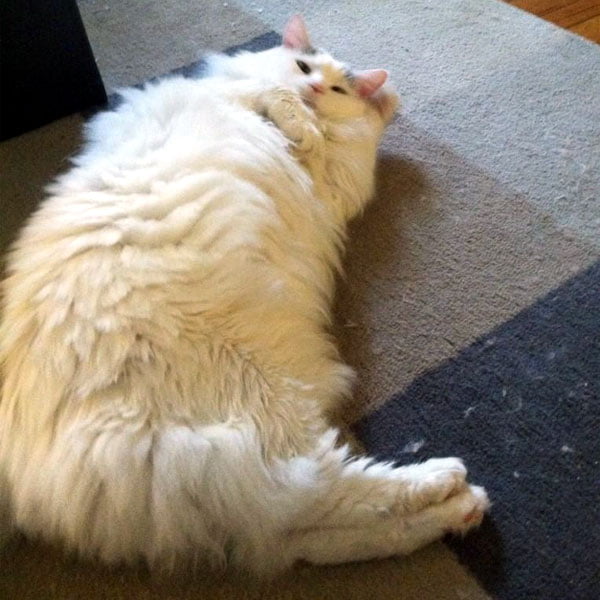Introduction: this is quite technical. It is essentially saying that a domestic cat’s diet should be altered to take into account the cat’s bodyweight and body composition in terms of lean tissue and fat as reflected in the cat’s ability to digest fat and protein which varies throughout their life. We know that commercially prepared food does address this issue.

It is possible to divide the life of the domestic cat into three stages in terms of body weight and nutrient requirements. A study by Nestlé Purina looked at the live stage physiology of the domestic cat to better understand the nutrient requirements in their diet for the different life stages.
Domestic cat body weight declines at a steady rate beyond the age of 9
The study found that bodyweight changed with age (as we know!) and increased steadily between the ages of 1-9. After the age of 9, bodyweight decreased at the rate of: bodyweight in kilograms = 6.6 – (0.2 × age in years). The formula is not that helpful to the average cat owner but let’s just say there’s a steady decline in bodyweight from the age of nine. They concluded that something happened to domestic cats around the age of 9 and that this is the point at which domestic cats could be considered old.
They also found that within that framework there were weight differences over three distinct age ranges. Cats in the group 1-7 years old had a mean weight in kilograms of 3.7 (+ or -0.8). Those cats in the age range 7-12 years had a mean body weight of 4.4 (+ or -1.7). And those in the group of 12+ had a mean weight of 2.9 kg (+ or -1.02). Overall, the average body weight was 4 kg for all the cats in study.
Over the age range 1-7 years cats tended to have an ideal body weight but with a tendency to increase weight with age. For those within the age range 7-12 years they were at risk of becoming overweight or even obese. And for those cats of 12 years of age and over (considered geriatric) their bodyweight tended to decrease progressively and become below ideal.

Fat and lean tissue content of cat’s bodies
In terms of what they call ‘body composition’, which I take to mean the amount of fat and lean tissue within the body of the participating cats, they found the following. For cats in the adult life stage (1-7 years old) cats have a mean of 10% body fat and 87% lean tissue. For those cats in the bracket 7-12 (considered the mature life stage) the cats increased their percentage of fat progressively reaching a mean of approximately 18% by nine years of age. One third of these cats were obese. This backs up the belief that all the cats tend to become overweight and obese which means that diet should be altered to contain fewer calories and fat.
When a cat becomes at or older than 12 years of age the percentage of body fat decreases. The mean lean tissue value after 12 years of age drops off dramatically and by the age of 15 geriatric cats have a mean lean tissue value under 2 kg which is about one third less than the mean during adulthood. Lean tissue is an indication of muscle mass. It controls the activity levels of the cat. Geriatric cats become less active and sleep more.
Digestibility of fat and protein declines in older cats
This information is relevant to the energy requirements of domestic cats. The study tried to explain the decreasing trends in bodyweight, body fat and lean tissue of geriatric cats. It suggested that metabolic efficiencies might be reduced in some organs. They also suggested that geriatric cats had reduced nutrient digestibility. They believe that the fat digestibility in healthy adult cats is about 90% to 95%. In some geriatric cats that digestibility was found to be as low as 30%. Fat is the most energy dense nutrient and if it can’t be digested it is likely to significantly impact changes in body weight and body composition.
In cats over the age of 14 there was a reduced digestibility of protein and about 1/5 of these cats were affected. Reduced protein digestibility was in parallel with reduced lean tissue in geriatric cats.
Nutrient requirements vary with age

In terms of bodyweight and reduction of lean tissue and body fat, they divided domestic cat into three stages in terms of age i.e. 1-7 (adult), 7-12 (mature), and over 12 (geriatric). Above is a table showing a suggested micronutrient profile of the diet for the different life stages of domestic cats. It shows that geriatric cats need increased energy in their food plus increased fat and increased protein. Water also needs to be increased. Conversely, in the mature age bracket, because there is a tendency to become obese, the diet should have reduced energy, reduced fat and moderate protein.
Click this link to read the study.
SOME MORE ON GERIATRIC CATS:

